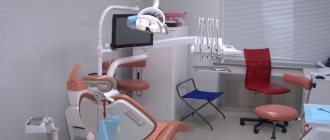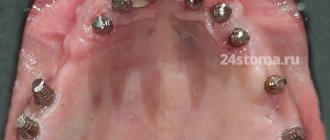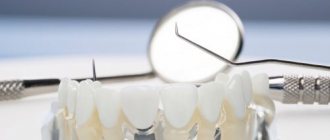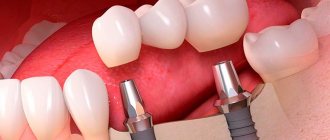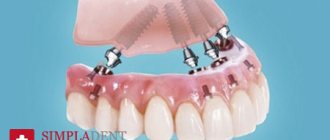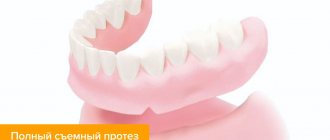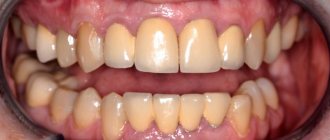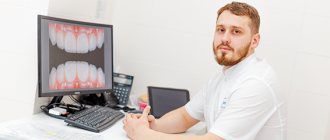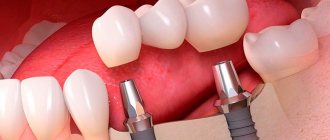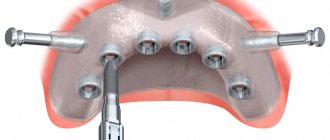Modern methods in dentistry, including the latest technologies in implantation, can solve almost any problem, including complete absence of teeth. However, installing a large number of implants entails large financial and time costs. It is not surprising that a system that requires only four implants and reduces surgical time can be considered the most optimal option for most patients. Dmitry Valerievich Levin, candidate of medical sciences, chief physician and implant surgeon of the Doctor Levin Center for Private Dentistry in Moscow, talks about the features of all-on-4 or “all on four” implantation.
What is All-on-4 implantation?
“All on four” implantation is the fixation of fixed dentures on four implants installed in the upper or lower jaw. The prosthesis is fixed on implants using special screws, which ensures good stabilization. Only a doctor can remove such a prosthesis; this usually happens twice a year - for inspection and necessary preventive measures. The patient’s attendance at such preventive examinations is strictly mandatory, as this prevents the development of possible complications.
“All on four”: differences from classical technology
Adentia is divided into two types - partial and complete. Partial implies the absence of a certain number of teeth, complete means a completely toothless jaw. Until recently, in case of complete loss of teeth, the options for reconstructing the dentition included removable prosthetics or the implantation of individual implants instead of each missing tooth. The choice was between an uncomfortable and unesthetic artificial jaw or significant costs for the operation. Everything changed with the advent of new implantation technology, which allows you to restore the entire dentition on 4 implants.
What are the indications for All on Four dental implants?
One of the indicators can be the small volume of bone tissue in both the upper and lower jaws. It is especially problematic with the required volume of bone tissue for implantation in the chewing sections, since in the absence of teeth for quite a long time, the volume of bone tissue in these sections decreases, and this happens even when using removable dentures. In order to install the number of implants required for fixing fixed prostheses (from 6 to 10), a preliminary operation is required to restore the required bone volume. Only after this are implants installed, and after some time (from three to eight months) prosthetics are performed on them.
Type of technique and comparison
All-on-4 on Dentium
Turnkey price
For patients with minimal bone loss
- Anesthesia and placement of 4 implants
- Sirona Conect digital impressions
- Fixation of a fixed adaptive prosthesis
- Fixation of a permanent all-zirconium prosthesis after 3-6 months
Payment is made in stages:
1st installment - 200,000 when installing an implant
2nd installment - 200,000 at the time of taking digital impressions and fixing the permanent structure
400 000
550 000
-27%
- In 1 day
- Installment plan 0%
- 10 year warranty
- Without pain
Make an appointment Initial consultation is free!
All-on-6 at SGS
Turnkey price
For patients with significant bone atrophy
- Anesthesia and placement of 6 implants
- Sirona Conect digital impressions
- Fixation of a fixed adaptive prosthesis
- Fixation of a permanent all-zirconium prosthesis after 3-6 months
Payment is made in stages:
1st installment - 250,000 when installing an implant
2nd installment - 250,000 at the time of taking digital impressions and fixing the permanent structure
500 000
- In 1 day
- Installment plan 0%
- 10 year warranty
- Without pain
Make an appointment Initial consultation is free!
All-on-4 at Nobel
Turnkey price
For patients with large bone defects
- Anesthesia and placement of 4 implants
- Sirona Conect digital impressions
- Fixation of a fixed adaptive prosthesis
- Fixation of a permanent all-zirconium prosthesis after 3-6 months
Payment is made in stages:
1st installment - 300,000 when installing an implant
2nd installment - 125,000 at the time of taking digital impressions
3rd installment - 125,000 at the time of fixing the permanent structure
550 000
- In 1 day
- Installment plan 0%
- 10 year warranty
- Without pain
Make an appointment Initial consultation is free!
What are the advantages of dental prosthetics with 4 implants?
If we compare the “All on Four” technique with the use of removable dentures, the difference will be that in the first case the risks of mucosal injury, bone loss, as well as difficulties with fixation and correction are reduced to zero.
A patient with a removable denture experiences discomfort both functionally and socially. Most people who use removable dentures experience some self-doubt, and sometimes even inferiority in their social status. Also, when installing “all on four” implants, as already mentioned, there is no need for a large number of implants. Due to the fact that these four implants are installed in certain positions in relation to each other: when implanting the front teeth - straight, and in the lateral teeth - at an angle of 35º to 45º, and also by creating a large distance between them, the chewing load is adequately distributed and is redistributed during operation. A small number of implants simplifies the operation, making it faster and more predictable, while ensuring excellent results.
Advantages and disadvantages of the method
The main advantage of the “All on 4” method is the reliability of fixation of the prosthesis in the oral cavity. In addition, the patient receives an aesthetic effect and the opportunity to eat fully from the moment the temporary prosthetic structure is installed. This technology significantly reduces trauma and stress on the body, because only 4 implants need to be implanted for one jaw, and not 10 - 12 titanium rods. This factor allows you to minimize the cost of implantation. Another advantage is the ability not to undergo osteoplasty (bone grafting) in case of minor or moderate bone atrophy. Rapid adaptation to the prosthesis also plays an important role. The patient does not feel the orthopedic structure as something foreign, chewing does not cause him discomfort, and diction does not change. A big bonus is the even distribution of the load on the jaw bone when chewing. This allows you to prevent the progression of its resorption (resorption).
The method does not have many disadvantages. For example, this technology cannot be implemented if the structure of bone tissue is excessively loose or if it is critically deficient. To be fair, it is worth noting that this is a contraindication for the use of any implantation technology. In such situations, it is necessary to perform preliminary bone grafting, i.e., increasing the volume and increasing the density of the bone.
What types of prostheses are used when implanting All-on-4?
For “All on Four” implantation, fixed prostheses are always used, which, however, can be called conditionally removable, because they are fixed with special screws, but at the same time they are fixed rigidly. The patient is not able to remove them while wearing them; I repeat, this can only be done by a doctor for regular checks.
Designs of this type have stood the test of time, showing excellent clinical results. The reliability of work done using this technology is beyond doubt. A large number of patients choose this technology and are very satisfied.
Preparation for implantation using All-on-4 technology
No special preparation is required, but if there are foci of infection in the planned location of the implants that can affect the quality of the intervention, they require preliminary relief. If there are roots of decayed teeth or loose teeth in the oral cavity, they are removed during surgery.
Before the operation, the patient must undergo examination: blood tests, X-ray diagnostics. If everything is in order and the patient does not suffer from systemic diseases, including diseases of the blood and immune system, he can safely count on this operation. We usually offer different types of implantation, but with such a defect as the complete absence of teeth in the upper or lower jaw, “all-on-four” implantation always wins: both in terms of treatment cost and time savings.
Make an appointment
right now!
Levin Dmitry Valerievich
Surgeon, Implantologist, Maxillofacial surgeon
Removable denture on implants. Opinion of an orthopedic dentist
Orthopedic dentist Vladislav Anatolyevich Chesnokov tells.
A removable denture is the fastest and most affordable method of treatment for the loss of a significant number or all teeth. However, it is not suitable for everyone. Some patients cannot get used to it and complain of discomfort.
Inconvenience of removable dentures
Patients note:
- May fall out while talking, chewing or laughing.
- In public, the patient is haunted by the fear of the prosthesis falling out and the associated awkwardness.
- The denture remains in the mouth, but when chewing you feel its mobility, this is distracting.
- Diction deteriorates as the prosthesis is made larger so that it holds better.
- It is necessary to constantly use a fixing gel.
Cases from my practice:
In addition to the problems that I described above, I remember a case when a patient could not talk for a long time with a removable denture in his mouth. Even after six months, he was not used to the prosthesis: by the middle of the day, his speech apparatus was tired, his diction sharply deteriorated, the prosthesis lost stability, and he had to be corrected right in the middle of a sentence. Since the patient worked as a dispatcher and could not speak less, we had to solve this problem.
I also remember a patient with a removable denture who could not smoke. Due to the tension in the cheeks and lips, the denture flew out of the mouth. The patient chose to get implants rather than give up his bad habit.
All these inconveniences are caused by one reason: insufficient stability of the prosthesis on the lower jaw. Removable dentures are designed to adhere to the gums, but this fixation is not always reliable.
Removable or on implants? Removable denture on implants!
In the last century, patients had to put up with the discomfort of removable dentures. But modern dentistry solves the problem with the help of implants. In this case, the dentures do not rest on the gums, but on artificial titanium roots implanted into the jaw.
The prosthesis is attached to the implants using special locks. The patient puts it on and takes it off when necessary to maintain oral hygiene.
A removable jaw on implants is an intermediate option or, if you like, a golden mean between an inexpensive and inconvenient removable denture and a highly aesthetic fixed structure on implants.
| Removable denture | Removable denture supported by implants | |
| Reliability of fixation | Low or medium | High |
| Comfort | Low or medium | High |
| Load on abutment teeth in partial dentures | Promoted. The entire chewing load on the prosthesis will be distributed over the supporting teeth. | Regular |
| Cost of treatment | Below | Higher, since implants and attachments to them are required. These are one-time costs: when replacing a prosthesis, the cost is almost equal |
Removable or non-removable?
A fixed prosthesis on 4 or 6 implants installed using the All-on-4 method will be even more convenient and beautiful. This type of treatment is more expensive, so it is important for the patient to weigh the pros and cons of the options.
| Removable denture on implants | Fixed prosthesis on 4 implants (All-on-4) | |
| Implants | 2-4 Fewer implants are required, resulting in lower costs and fewer procedures. | 4-6 The costs of implants and their installation are higher. |
| Cost of prosthesis | Average | Medium, high or very high. Depends on the chosen orthopedic design. |
| Hygiene | Better quality. The prosthesis is pulled out, all its parts are available for cleaning. | Convenient. The denture is cleaned like your own teeth, in the oral cavity. There are hard-to-reach places that only a doctor can reach. |
| Life time | Less | More |
| Aesthetics | Average | Medium or very high, depending on the chosen orthopedic design |
Prosthesis on 3 implants
An ordinary removable denture fell off during a conversation. Now it is securely fixed in the patient's mouth.
Prosthesis on 2 implants
The reinforced structure is secured using ball-shaped locks. They are not visible when the prosthesis is worn.
What does a prosthesis look like?
The photo shows locks in the patient’s mouth and 2 dentures: on implants for the lower jaw and a regular one for the upper jaw.
Service life of removable dentures on implants
I note that the service life of implants is not limited, they do not need to be changed. Fasteners can fail, but this is very rare: the metal from which they are made is quite strong. Over time, only the prosthesis itself and the rubber elements of the locks with which it is attached will require replacement.
Good removable teeth on implants last about 5 years on average. This period can be shortened by insufficient hygiene, as well as careless handling and, consequently, multiple repairs.
Also pay attention to the material from which removable teeth with implant fixation are made. I like cold cured acrylic from the Dutch company Vertex. It is distinguished by a high precision fit to the gums, and this is a matter of aesthetics and comfortable hygiene. There is no need to get carried away with saving money here: a prosthesis made of cheap plastic will quickly lose its natural appearance, begin to become saturated with food odors, and become a breeding ground for bacteria. Accordingly, it will require replacement sooner.
FAQ
Is it possible to change it?
Patients often ask me whether a regular removable jaw can be converted into a prosthesis that will be fixed with implants. Yes, if we are talking about a complete and not a partial denture, then this is possible if 2 conditions are met:
- The prosthesis is not reinforced,
- The prosthesis was made recently: less than 2-3 years ago.
How many implants are needed?
The minimum number is 2, and most removable jaws are fixed on 2 implants. But in some situations it is better to set 4. Everything is very individual, depending on the condition of the jaw bone.
For the upper or lower jaw?
Removable dentures on implants are usually made for the lower jaw. A denture on the upper jaw rarely causes problems with fixation: it sticks not only to the gums, but also to the palate. Most patients are comfortable with the option of having a regular prosthesis on the upper jaw and a removable prosthesis on the lower jaw.
If a conventional denture is uncomfortable even on the upper jaw, and this happens in patients with an increased gag reflex, the artificial palate interferes with them. In such cases, a non-removable design on implants is suitable: with a beam fixation system or made using All-on-4 technology.
The quality of life
As part of my scientific work, I conducted research on the quality of life of patients. In particular, I studied how patient problems were solved when switching from conventional removable dentures to implant-supported removable teeth. The most significant changes were found in the criteria “inconvenience when chewing food” and “discomfort in communicating with people.”
These problems are not just an inconvenience. Patients with removable dentures are, as a rule, elderly people. For them, insufficient chewing of food can lead to immediate digestive problems. And stress during communication will lead to a decrease in social contacts, a feeling of loneliness and even conflicts with loved ones.
It is extremely important to recognize in time that a conventional removable denture is not suitable for you or your elderly parent. Fortunately, there is a solution. Contact your doctor and see for yourself how your family's quality of life improves.
All-on-4 implantation technologies
This operation, in its essence, differs little from a number of similar implantation operations. Its only difference is that after installing the implants, provided they have good primary fixation, they immediately begin to “work.” This means that they can either be immediately fitted with a new fixed prosthesis, or the patient’s old (removable) prosthesis can be fixed, making it permanent. This manipulation usually takes about 3 - 4 hours. The mucous membrane, injured during surgery, does not suffer at all, since the load is not distributed on it, but directly on the installed implants. In fairly complex cases, when the volume of bone tissue is minimal, the patient will be advised to make an individual template made in 3D format based on a tomogram image. At the preparatory stage, the doctor plans the route of insertion of the implants into the jawbone, and only then during the operation they are installed using a manufactured template. After 4-6 months, during which a temporary fixed prosthesis is used, a permanent fixed prosthesis is made that will last for many years.
Photos before and after All on Four implantation
Contraindications
Relative contraindications to all on 4 implantation are inflammatory diseases of the oral mucosa and caries. After sanitation, implants can be installed.
It is strictly forbidden to do prosthetics using this method if the patient is diagnosed with:
- oncological processes in the body;
- blood diseases;
- inflammation in the acute phase of any localization;
- diabetes;
- drug addiction;
- tuberculosis;
- exacerbation of mental pathology.
Are there any complications after the procedure?
Complications, of course, occur, for example, such as a fracture of the base of the prosthesis, but this can only happen with a temporary structure. With permanent restoration this is unlikely to happen. Also, at the early postoperative stage, inflammation of the mucous membrane may occur, but in the future, the formed mucous membrane remains healthy with proper care. The worst thing that can happen is perimlantitis - inflammation of the tissue near the implant caused by the appearance of pathogenic microbes between the implant and the bone tissue that holds it. That is, in essence, this is the destruction of the bone fragment that holds the implant. However, with careful care and good oral hygiene, in particular denture hygiene, this will not happen.
Myth 2. Immediate loading impairs the healing process of the gums
If “All on 4 implants” prosthetics is used, the adaptive structure can be installed immediately after completion of surgical procedures. This means the patient goes home with new teeth to chew on. And this does not interfere with the healing process. On the contrary, the load helps improve blood supply, lymphatic drainage and local metabolism in the surgical area. However, during the first week you need to follow a special diet and take medications prescribed by your doctor.
